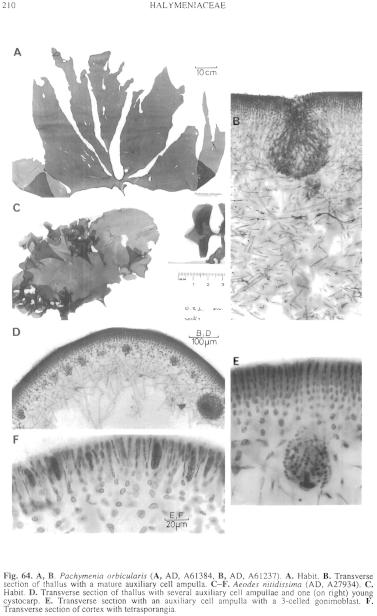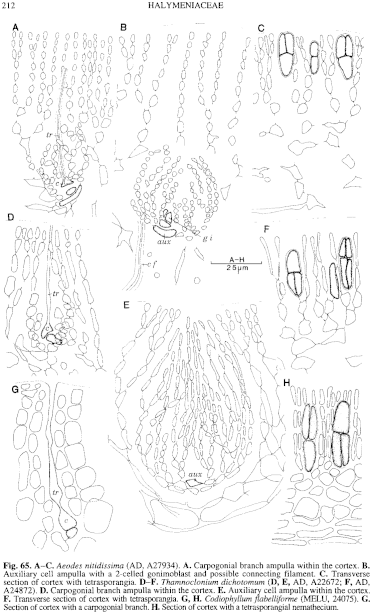|
|
|
|
|
|||||||||||
|
Electronic Flora of South Australia Species Fact Sheet
Phylum Rhodophyta – Class Florideophyceae – Order Gigartinales – Family Halymeniaceae
Selected citations: Chapman & Parkinson 1974: 254, fig. 73. Chiang 1970: 6, figs 1, 2, pl. 1. Kraft 1977c: 47, fig. 9.
Thallus (Fig. 64C) medium to dark red, fading to yellow-red, uniformly coloured to mottled, foliose, 5–15 cm high with lobes 3–5 cm broad and smaller convolute marginal lobes 0.5–1.5 cm broad, surface usually shiny when dried, margin smooth, 400–600 µm thick, adhering to paper when young but often not when older; stipe short. Holdfast discoid, 1–3 mm across, epilithic. Structure (Fig. MD) with a cortex 45–100 µm and 10–14 cells thick, consisting of an outer cortex 30–40 µm thick of 6–8 cells branched every 2–4 cells, outer cells 1–2 µm in diameter and L/D 2–3, and an inner cortex of relatively few widely separated cells, irregular in shape and 5–10 µm across, not becoming stellate. Medulla lax, of widely separated irregularly arranged filaments 3–4 µm in diameter, with some slenderer (rhizoidal) filaments; refractive ganglionic cells absent.
Reproduction: Sexual thalli probably dioecious. Carpogonial branch ampullae (Fig. 65A) in the inner cortex, with a few secondary filaments more or less erect. Auxiliary cell ampullae (Figs 64D, E, 65B) very numerous, in the inner cortex, 20–45 µm across, with numerous secondary filaments of 10–15 short cells and some shorter tertiary filaments, with the filaments relatively loose and open above (not converging). Carposporophyte (Fig. MD) compact, rounded, 50–100 µm across, with the basal auxiliary cell laterally elongate and ovoid to angular carposporangia 6–10 µm across; involucre conspicuous, 20–25 µm thick, of several lax filaments, derived from the ampullary filaments which develop many further short branches; ostiole absent. Spermatangia not observed.
Tetrasporangia (Figs 64F, 65C) cut off from mid cells of the outer cortex and lying just within the surface, elongate, 20–27 µm long and 6–8 µm in diameter, cruciately divided.
Type from Tauranga, New Zealand (Berggren); holotype in Herb. Agardh, LD, 22363.
Selected specimens: Blackmans Bay, S of Hobart, Tas., lower eulittoral (Sanderson, 24.xi.1991; AD, A61521). Taroona, Tas., lower eulittoral (Womersley, 13.i.1949; AD, A10141; Cribb, 17.ii.1951; AD, A16192; and Sanderson, 24.xi.1991; AD, A61525) and upper sublittoral (Wollaston & Mitchell, 28.ii.1964; AD, A27934). Kingston Beach, Tas., 2–3 m deep (Kraft, 12.v.1976; MELU, A39931).
Distribution: New Zealand. SE Tasmania.
Taxonomic notes: The above Tasmanian collections agree well with specimens of Aeodes nitidissima from New Zealand and with Chiang's description.
References:
AGARDH, J.G. (1876). Species Genera et Ordines Algarum. Vol. 3, Part 1 - Epicrisis systematis Floridearum, pp. i-vii, 1–724. (Weigel: Leipzig.)
CHAPMAN, V.J. & PARKINSON, P.G. (1974). The marine algae of New Zealand. Part DI: Rhodophyceae. Issue 3: Cryptonemiales. (Cramer: Germany.)
CHIANG, Y.-M. (1970). Morphological studies of red algae of the family Cryptonemiaceae. Univ. Calif Pubis Bot. 58, 1–83, Plates 1–10.
KRAFT, G.T. (1977c). The morphology of Grateloupia intestinalis from New Zealand, with some thoughts on generic criteria within the family Cryptonemiaceae (Rhodophyta). Phycologia 16, 43–51.
The Marine Benthic Flora of Southern Australia Part IIIA complete list of references.
Publication:
Womersley, H.B.S. (14 January, 1994)
The Marine Benthic Flora of Southern Australia
Rhodophyta. Part IIIA, Bangiophyceae and Florideophyceae (to Gigartinales)
Reproduced with permission from The Marine Benthic Flora of Southern Australia Part IIIA 1994, by H.B.S. Womersley. Australian Biological Resources Study, Canberra. Copyright Commonwealth of Australia.
Illustrations in Womersley Part IIIA, 1994: FIGS 64 C–F, 65 A–C.

Figure 64 enlarge
Fig. 64. A, B. Pachymenia orbicularis (A, AD, A61384, B, AD, A61237). A. Habit. B. Transverse section of thallus with a mature auxiliary cell ampulla. C–F. Aeodes nitidissima (AD, A27934). C. Habit. D. Transverse section of thallus with several auxiliary cell ampullae and one (on right) young cystocarp. E. Transverse section with an auxiliary cell ampulla with a 3-celled gonimoblast. F. Transverse section of cortex with tetrasporangia.

Figure 65 enlarge
Fig. 65. A–C. Aeodes nitidissima (AD, A27934). A. Carpogonial branch ampulla within the cortex. B. Auxiliary cell ampulla with a 2-celled gonimoblast and possible connecting filament. C. Transverse section of cortex with tetrasporangia. D–F. Thamnoclonium dichotomum (D, E, AD, A22672; F, AD, A24872). D. Carpogonial branch ampulla within the cortex. E. Auxiliary cell ampulla within the cortex. F. Transverse section of cortex with tetrasporangia. G, H. Codiophyllum flabelliforme (MELU, 24075). G. Section of cortex with a carpogonial branch. H. Section of cortex with a tetrasporangial nemathecium.

|
Email Contact: State Herbarium of South Australia |

|